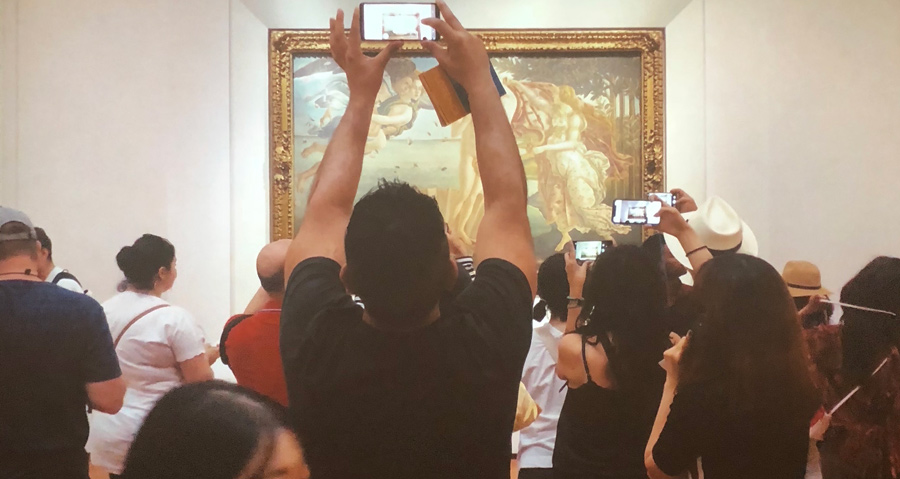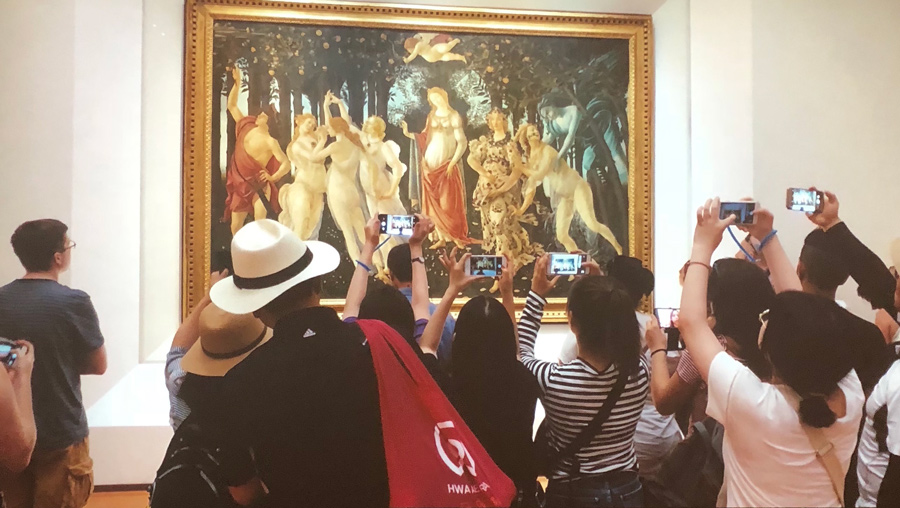
Uffizi Galleries, Florence
July 30, 2018 – February 24, 2019
The Uffizi describes the Uffizi
by Camilla Torracchi (University of Florence)
Near the Statue of Lorenzo the Magnificent, at the entrance to the Uffizi Galleries, the words Grand Tourismo stand out on a green banner. It is the title of the exhibition of artist Giacomo Zaganelli currently open and available until 24 february 2019.
The exhibition, in room 56 of the museum, offers visitors the chance to view three videos by the Florentine artist.
In the first work, Everywhere but nowhere, we are shown a young man sitting behind Palazzo Strozzi in Florence who seems totally alienated from the real world and immersed in virtual reality. In Illusion the streets of the city center of Florence are the protagonists, and are reduced to a background for tourists morbidly taking pictures of the beautiful city. Uffizi Oggi, realized exclusively for the Uffizi Galleries, shows a flood of people amassed in front of Botticelli’s works only long enough to take a picture.
To create the last video, the artist visited the museum on a Sunday with free admission and filmed visitors behaviour in the Botticelli room for three hours. Zaganelli, who I interviewed, explained that he used a smartphone to film so that he would be confused amongst the tourists and remain unobserved.
The video Uffizi Oggi suggests a different way to read the famous masterpieces. Spring and The Birth of Venus have in fact become icons to be observed through the lens of a camera, they seem to no longer exist, transformed into digital images that prove the single visitors presence in the museum so that they can say: ‘I’ve been there, I’ve seen it’.
The exhibition is curated by the director of the Uffizi Eike Schmidt and Chiara Toti and the strong impact of the video is tied to a precise choice of music. At the entrance of the room there is no indication of the presence of the exhibition. Visitors enter the room and are surprised to find a semi-empty room, with irregular white walls and a few benches placed in front of the videos inviting visitors to sit down and reflect with total liberty the break in reality that Zaganelli filmed.
The protagonists of the video are the visitors that we have shared the first part of the visit with, or ourselves, who like looking in a mirror, are shown and recognize our behaviour projected on the wall. Only at the end of the room do we find a panel that allows us to learn the name of the artist and some information about the exhibition.
Grand Tourismo offers visitors the opportunity to question the approach of reality with the invention of devices and the modern way in which we experience and museum and its collection.
The choice of the room is interesting, number 56, which previous held the collection of Hellenistic marbles that today are conserved in the Verone rooms. It is a space that must be crossed in follow the museum visit, and instead of turning the room into a mere place of passage, it was decided that the exhibition should be set up there. In doing so the museum offers all of its visitors the possibility to compare themselves with the artist’s videos, and maybe to continue the visit with less of a filter between themselves and the works.
If on one hand the ban of taking photographs inside museums has brought advantages, on the other it has changed the behaviour of the visitors. As Eike Schmidt, the director of the Uffizi Galleries has said: ‘Starting with a reflection of the entirety of the Uffizi and focusing on the most visited room, where Botticelli’s masterpieces are housed, through the interpretation of Giacomo Zaganelli we wanted to focus on a phenomenon that, changing the relationship between the spectator and the work of art, implies a rethinking of the functions of the museum itself.
The ideal traveller of the Grand Tour is transformed in the artist’s videos in that of Grand Tourismo, a frantic collector of images. The work of art is deprived of its artistic value, as documented by the videos on display, giving us the impression of being in the halls of a museum or on the streets of Florence, but it is only an illusion of being in any place when in reality it is nowhere.
Translation by Marie-Claire Desjardin (Istituto Lorenzo de’ Medici)
Giacomo Zaganelli. Grand Tourismo

Gallerie degli Uffizi, Firenze
30 luglio 2018 – 24 febbraio 2019
Gli Uffizi raccontano gli Uffizi
di Camilla Torracchi (Università degli studi di Firenze)
Vicino la statua di Lorenzo il Magnifico, all’ingresso delle Gallerie degli Uffizi, spicca su un telo verde la scritta Grand Tourismo. Questo è il titolo della mostra dell’artista Giacomo Zaganelli attualmente in corso e visitabile fino al 24 febbraio 2019.
Il percorso espositivo allestito nella Sala 56 del museo propone la visione di tre video dell’artista fiorentino.
Nel primo lavoro, Everywhere but nowhere, vediamo un ragazzo seduto alle spalle di Palazzo Strozzi di Firenze che sembra alienato dal mondo reale e totalmente immerso in quello virtuale. In Illusion le vie del centro di Firenze sono protagoniste e ridotte a sfondo per turisti che morbosamente si fotografano fra le bellezze della città. Uffizi Oggi, realizzato in esclusiva per le Gallerie degli Uffizi, mostra una fiumana di persone ammassate di fronte alle opere di Botticelli solo il tempo sufficiente per scattare una foto.
Per realizzare quest’ultimo video, l’artista si è recato al museo in una domenica con ingresso gratuito e ha filmato per tre ore il comportamento dei visitatori presenti nella Sala di Botticelli. Zaganelli, da me intervistato, spiega di aver utilizzato per le riprese uno smartphone così da confondersi fra i turisti e passare inosservato.
Il video Uffizi Oggi vuole suggerire un modo diverso di leggere questi famosi capolavori; La Primavera e la Nascita di Venere infatti sono divenute icone da osservare attraverso il filtro di una fotocamera, sembrano quasi non esistere più, trasformate in immagini digitali che testimoniano la presenza nel museo del singolo visitatore per poter dire: “ci sono stato, l’ho vista”.
La mostra è curata dal direttore delle Gallerie degli Uffizi Eike Schmidt e Chiara Toti e il forte impatto dei video è legato ad una scelta museale precisa. All’ingresso della sala niente allude a ciò che vi sarà dentro, non ci sono cartelli o pannelli che indichino la presenza della mostra. Si entra nella stanza e si rimane sorpresi in una sala semivuota, con pareti bianche dal profilo irregolare e alcuni divanetti posti di fronte ai video che ci invitano ad accomodarci e a riflettere in totale libertà su spaccati di realtà che Zaganelli ha filmato.
Protagonisti dei video sono i visitatori con cui abbiamo condiviso la prima parte della visita, o noi stessi che, come di fronte ad uno specchio, rivediamo e riconosciamo i nostri comportamenti proiettati sul muro.
Solo al termine della sala troviamo il pannello che ci permette di conoscere il nome dell’artista e alcune informazioni sulla mostra.
Grand Tourismo offre al visitatore la possibilità di interrogarsi sull’approccio al reale con l’avvento dei devices e sul modo con cui oggi si vive un museo e le collezioni che esso contiene.
Interessante è la scelta della sala, la numero 56, che prima della mostra ospitava la collezione di marmi ellenistici oggi conservati nel Verone. Si tratta di un luogo che è necessario attraversare per proseguire la visita al museo, e invece di trasformare la sala in un mero luogo di passaggio, si è scelto di allestire qui la mostra. In questo modo il museo offre a tutti i suoi visitatori la possibilità di confrontarsi con i video dell’artista, e forse di proseguire la visita con un filtro in meno fra l’uomo e l’opera.
Se da un lato l’abolizione del divieto di fotografare all’interno dei musei ha portato dei vantaggi, dall’altro ha cambiato il comportamento del pubblico che vi si reca in visita. Come dichiara il direttore delle Gallerie degli Uffizi Eike Schmidt: “partendo da una riflessione intera agli Uffizi e incentrata sulla sala più frequentata, quella dei capolavori di Botticelli, attraverso l’interpretazione di Giacomo Zaganelli abbiamo voluto porre l’attenzione su un fenomeno che, mutando la relazione tra spettatore e opera d’arte, implica un ripensamento delle funzioni del museo stesso”.
L’ideale viaggiatore del Grand Tour si è trasformato nei video dell’artista in quello del Grand Tourismo, un collezionista frenetico di immagini. L’opera d’arte è privata del suo valore artistico, come documentano i video in mostra, dandoci l’impressione di essere nelle sale di un museo o fra le vie di Firenze, ma è solo l’illusione di essere in qualunque posto e nessun posto realmente.
Photo courtesy Camilla Torracchi